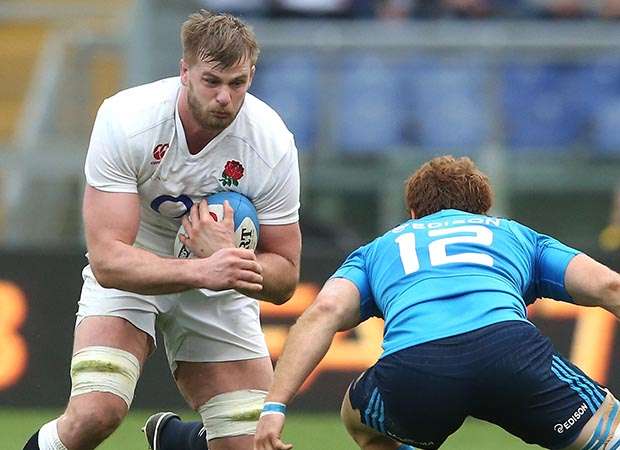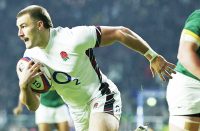
He has achieved both in the past year, and is in the process of forming a world class second-row pairing with Maro Itoje for club and country. That is some CV for a player who doesn’t always grab the headlines, but is a forward who invariably brings the added extra. Kruis not only does what he’s meant to as a good second-row forward at the set-piece and in the loose, he does more. Always. And it’s the more that counts and puts him into Player of the Year territory.
Kruis and Itoje complement each other because they know their own roles, and each other’s roles, incredibly well. Itoje is marginally shorter, as well as younger and greener. He’s so eager to get involved in everything he possibly can, but he hasn’t learned yet when not to go in.
Kruis, on the other hand, knows exactly when and where to make his presence felt. He bides his time and then makes the right call. When you look at when Bakkies Botha and Victor Matfield were the best second-row partnership in Test rugby it was because they were opposites. Matfield was not the bulkiest but he was a great lineout jumper and could run everywhere, whereas Botha was the physical powerhouse, but slower and less agile.
When you look at Kruis and Itoje they are made from the same mould – and it is a mould in which it is very hard to find a weakness.
With Kruis it is his constant ability to carry the ball compactly and get over the gain-line that instils confidence and gives his side momentum. He is there to make the hard yards when it counts, and he’s also there when Saracens and England need to stop the opposition from making inroads.
His ability to make important tackles, and then get to his feet immediately to make another, is a core component in keeping the integrity of the defensive line intact. When any of his team-mates see that someone of 6ft 6ins and 18 stone is making 14 tackles a game it’s inevitable that they start thinking, ‘if he’s always there then I should be too’.
Kruis has made his mark after coming in a bit under the radar over the last year, but the big tests that will cement his reputation will keep on coming. He had Luke Charteris to contend with first in the European Cup final and that will be followed by the challenge of the Wallaby pack next month.
Kruis wasn’t making the England team regularly under Stuart Lancaster, but he’s proved to Eddie Jones that he has all the right qualities. He’s got the size, the engine, the physicality, and the work rate and the desire – and it’s a success story that is made sweeter still because he was a late developer who was let go by Harlequins.
Kruis is incredibly fit. He’s realised that you’ve got to be on your feet to tackle and carry, and that you’re no good to anyone on the floor. Even more important, peak fitness gives you greater capacity to absorb the pressure mounted by the opposition, and to make the right decisions, whether it’s calling lineouts or tackling.
Maximum fitness has to be a given at international level. There’s also a high emphasis put on it at Saracens, and that’s what has put Kruis and company within sight of the top trophies. It is the mind-numbing, gruelling training that gets you there, and it is the hardest part of a pro rugby player’s job. The eight to 12 week pre-season period is a grind, and hugely boring – there’s nothing exciting about hurting – but it’s what helps you take make the hard yards in the winter.
What Kruis has shown is a dedication to improve at everything. For instance, he’s not the biggest lock bulk-wise, and is probably not quite quick enough to be a blindside flanker, but through sheer hard work he has developed into a world class lock.
He has put on the muscle he needs, and with that and good body-position he has developed the strength to drive through tackles, as his try against Scotland in the Six Nations showed. Importantly, he has also managed to retain the athleticism and flexibility to be a top class lineout jumper.
Kruis has made it impossible for coaches like Mark McCall or Eddie Jones to leave him out. The other thing about consistently good players like Kruis is that they become leaders. When it comes to captaincy, you embrace it, or say it is not for me. Kruis calls lineouts, and given that there are around 25 lineouts in every international game that makes you an influential figure. You need to have your wits about you to do that job. You need to be calm and calculating, and have the right strategy whether it is on your own throw or the opposition’s.
At 26, Kruis is gaining in maturity and experience, and so he could be a captaincy candidate for England if and when Dylan Hartley is superceded.
You make it when you make it in pro-sport. Paul Ackford was an even later developer then Kruis, and Courtney Lawes is another who came to the game relatively late. It is also worth considering Jamie Vardy was playing at grounds like Twerton Park in Bath two seasons ago – and now he’s a Premier League champion with Leicester City!
Kruis has not always called the lineouts, but Steve Borthwick‘s work ethic at Saracens has rubbed off on him, and he has picked up the baton. It’s about setting standards, and Kruis has that attitude to aim high by doing what it takes whether that’s studying, analysis, gym-work or running.
The pay-off for that effort is when you find you that you can run faster, jump higher and tackle harder than ever before. Then comes that light-bulb moment when you realise that you can play 80 minutes flat-out and be consistently excellent in the most demanding conditions imaginable. That’s where George Kruis is now.























